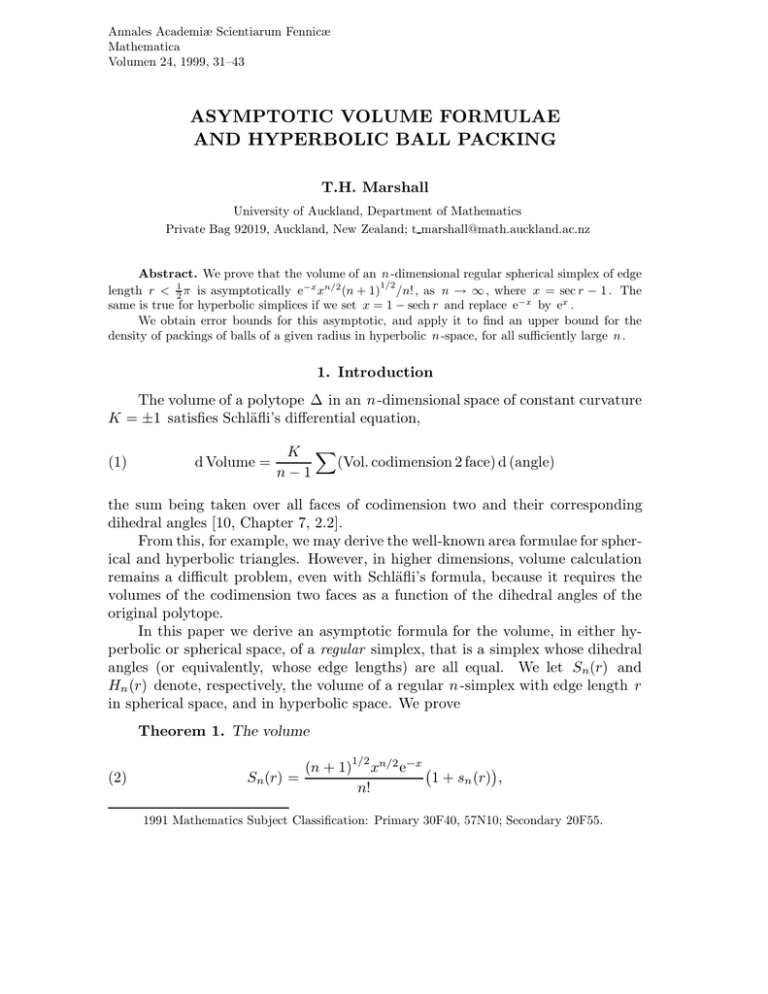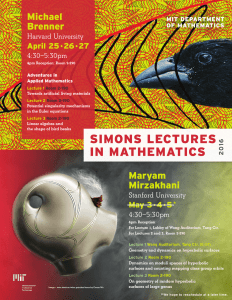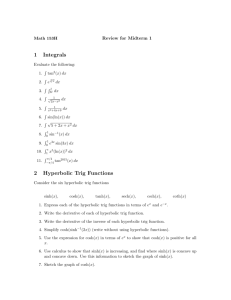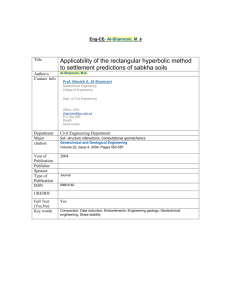ASYMPTOTIC VOLUME FORMULAE AND HYPERBOLIC BALL PACKING T.H. Marshall
advertisement

Annales Academiæ Scientiarum Fennicæ
Mathematica
Volumen 24, 1999, 31–43
ASYMPTOTIC VOLUME FORMULAE
AND HYPERBOLIC BALL PACKING
T.H. Marshall
University of Auckland, Department of Mathematics
Private Bag 92019, Auckland, New Zealand; t marshall@math.auckland.ac.nz
Abstract. We prove that the volume of an n -dimensional regular spherical simplex of edge
1/2
length r < 12 π is asymptotically e−x xn/2 (n + 1) /n! , as n → ∞ , where x = sec r − 1 . The
same is true for hyperbolic simplices if we set x = 1 − sech r and replace e−x by ex .
We obtain error bounds for this asymptotic, and apply it to find an upper bound for the
density of packings of balls of a given radius in hyperbolic n -space, for all sufficiently large n .
1. Introduction
The volume of a polytope ∆ in an n -dimensional space of constant curvature
K = ±1 satisfies Schläfli’s differential equation,
(1)
d Volume =
K (Vol. codimension 2 face) d (angle)
n−1
the sum being taken over all faces of codimension two and their corresponding
dihedral angles [10, Chapter 7, 2.2].
From this, for example, we may derive the well-known area formulae for spherical and hyperbolic triangles. However, in higher dimensions, volume calculation
remains a difficult problem, even with Schläfli’s formula, because it requires the
volumes of the codimension two faces as a function of the dihedral angles of the
original polytope.
In this paper we derive an asymptotic formula for the volume, in either hyperbolic or spherical space, of a regular simplex, that is a simplex whose dihedral
angles (or equivalently, whose edge lengths) are all equal. We let Sn(r) and
Hn (r) denote, respectively, the volume of a regular n -simplex with edge length r
in spherical space, and in hyperbolic space. We prove
Theorem 1. The volume
(2)
Sn(r) =
1 + sn (r) ,
1/2 n/2 −x
(n + 1)
x
n!
e
1991 Mathematics Subject Classification: Primary 30F40, 57N10; Secondary 20F55.
32
T.H. Marshall
where x = sec r − 1 and, for each r0 <
|sn (r)| < C/n , whenever r ≤ r0 , and,
(3)
Hn (r) =
1
π,
2
there is a constant C for which
1/2 n/2 x
(n + 1)
x
n!
e
1 + hn (r) ,
where x = 1 − sech r , and there is a constant C for which |hn (r)| < C/n , for all
r ∈ [0, ∞] .
The case r = ∞ (x = 1 ) of (3) corresponds to the regular ideal simplex. The
asymptotic (3), in this case, is given (without proof) by Milnor [8] (see [4] for a
proof).
Of course (2) and (3) are closely related, and we obtain both as a corollary of
Theorem 3 below, which also provides a related asymptotic expansion.
We also apply Theorem 3 to prove a result about ball packing in hyperbolic
space. The local density of a packing is defined to be the ratio Vol.(B)/Vol.(D) ,
where B is a ball in the packing, and D is the set of all points closer to B than to
any other ball in the packing. Böröczky [1, Theorems 1 and 4] has shown that the
local density of a packing by balls of radius 12 r is bounded above by the dn (r),
defined as follows.
Let ∆ be a regular simplex in hyperbolic n -space, with edge length r , and
let P be the union of n + 1 mutually tangent balls of radius 12 r with centres at
each of the vertices of ∆ . We define,
dn (r) = Vol.(P ∩ ∆)/Vol.(∆).
The limiting value dn (0) = limr→0 dn (r) is obtained by doing the same construction in Euclidean space, in which case the dimensions of ∆ are immaterial.
The limiting version of Böröczky’s result is that the density Dn of an n dimensional ball packing in Euclidean space does not exceed dn (0). This result
was proved by Rogers [9]. Asymptotically better estimates have since been found
(see e.g. [5]).
The function dn (r) has been proved to be strictly increasing, for n = 2
by Krammer (cited in [3, §37]), and for n = 3 by Böröczky and Florian [2].
Kellerhals [6] raises the question of whether this monotonicity also occurs in higher
dimensions. For sufficiently high dimension we answer this question affirmatively.
Theorem 2. For all sufficiently large n , dn (r) is a strictly increasing function
of r .
We conjecture that this result holds in all dimensions greater than one. The
methods given here allow this to be tested in principle, but only through lengthy
and tedious calculations. We therefore prove only the asymptotic result.
Since, for all r , dn (r) < 1 , monotonicity implies that, for each n , dn (r)
approaches a limit dn (∞) as r → ∞ . The local density of a packing by balls of
Asymptotic volume formulae and hyperbolic ball packing
33
any given radius is then bounded above by dn (∞). This result has been used,
when n = 3 , to obtain improved lower bounds for the volumes of hyperbolic
3 -manifolds and orbifolds. Details may be found in [7].
We use x to denote the greatest integer not exceeding x. Given two functions f(n) and g(n), defined on the natural numbers, we use f(n) ∼ g(n) to denote
asymptotic equality. For taking half integer powers of negative numbers we adopt
1/2
(2n+1)/2
the convention that (−1)
= i, whence (−1)
is i or −i, according as n
is even or odd.
I would like to thank G.J. Martin for reading and correcting an earlier draft
of this paper.
2. Simplex volumes
The edge length r and the dihedral angle θ of a regular n -dimensional spherical simplex are related by the well-known formula,
(4)
sec θ = sec r + (n − 1)
The same equation, with sech r replacing sec r , holds for the regular hyperbolic n -simplex. Thus, in the spherical case,
(5)
dr d sec r d sec θ
sec θ tan θ
dr
=
=
dθ
d sec r d sec θ dθ
sec r tan r
2
sec r + (n − 1)
sec r + (n − 1) − 1
√
=
.
sec r sec2 r − 1
The same equation holds in the hyperbolic case, with sech r replacing sec r and a
sign change on the right hand side and under the square root in the denominator.
The faces ofregular
simplex all have the same edge length as the original simn+1
plex. There are 2 faces of codimension two, so that, for the regular spherical
simplex with dihedral angle θ , Schläfli’s equation may be written
(6)
1
n+1
dSn(r)
=
Sn−2(r).
dθ
n−1
2
Similarly we have, in the hyperbolic case,
(7)
dHn (r)
−1 n + 1
Hn−2 (r).
=
dθ
n−1
2
34
T.H. Marshall
If z = sec r − 1 , then (6) gives,
dSn(r) dθ dr
dSn (r)
=
dz
dθ dr dz
n(n + 1)
Sn−2 (r)
=
1/2
2
2(n − 1)
(n + z) (n + z) − 1
−1 −1/2
1/2 (n + 1)
z
z
=
1+
1+
3/2
n
n+1
2(n − 1)
−1/2
z
× 1+
Sn−2 (r).
n−1
(8)
We obtain the corresponding equation for hyperbolic volumes by substituting
Hn (r) and Hn−2 (r) for Sn (r) and Sn−2(r), respectively, setting z = sech r − 1 ,
and multiplying the right hand side by −1 . Thus if we define a family of functions
Vn (z) by
V1 (z) = ArcSec (1 + z)
V0 (z) = 1,
and, for n ≥ 2
Vn (z)
(9)
−1 −1/2 −1/2
z
z
z
1+
1+
1+
=
Vn−2 (z),
3/2
n
n+1
n−1
2(n − 1)
(n + 1)
1/2
n/2
with Vn (0) = 0 , then Sn (r) = Vn (sec r − 1), and Hn (r) = (−1) Vn (sech r − 1).
Rather than using the functions Vn (z), it will be more convenient to work with
the related family Yn (z), given by
Yn (z) =
n!
( 12 n)!(n
1/2
+ 1)
Vn (z).
These satisfy the simpler equation
−1 −1/2 −1/2
z
z
z
Yn−2 (z)
(10)
Yn (z) = 1 +
1+
1+
n
n+1
n−1
for n ≥ 2 with initial condition Yn (0) = 0 . Together with the initial functions,
Y0 (z) = 1,
1/2
7
2
z 1/2 −z 1 + z + ··· ,
Y1 (z) =
ArcSec (1 + z) = 1 e
π
12
( 2 )!
(10) can be taken as defining the family Yn (z). Now we have
1/2
(11)
( 1 n)!(n + 1)
Sn(r) = 2
n!
Yn (sec r − 1)
Asymptotic volume formulae and hyperbolic ball packing
35
and
(12)
Hn (r) = (−1)
1
−n/2 ( 2 n)!(n
+ 1)
n!
1/2
Yn (sech r − 1).
Clearly for n even, Yn can be defined on the complex plane with the interval
(−∞, −1)
√ deleted, and is analytic in the interior of this region. For n odd,
Yn (z)/ z has the same properties.
Theorem 3. For each positive integer k ,
k−1
(n)
z n/2 −z
i
k (n)
1+
e
ri z + z εk (z)
Yn (z) = 1
( 2 n)!
i=1
(13)
(n)
= 1 ) we have,
where (setting r0
(n)
(14)
ri
∼ λi n−(i+1)/2
as n → ∞,
the λi being defined recursively by λ0 = 1 , λ1 =
λi =
(15)
3
2
, and,
3λi−2
i
for even i ≥ 2 and,
(16)
λi =
[−4λi−3 + 3λi−2 ]
− 2λi−1
(i − 1)
for odd i ≥ 3 . For each compact region in C − (−∞, −1),
|εk (z)| ≤ Kn−(k+1)/2 ,
(n)
(17)
where K depends only on the region chosen.
Clearly Theorem 1 follows from Theorem 3 (with k = 1 ), using (11) and (12).
Setting, for n ≥ 2 ,
hn (z) =
(18)
=
z
1+
n
∞
i=0
−1 1+
(n)
ti z i
=
k−1
i=0
z
n+1
(n)
−1/2 (n)
z
1+
n−1
ti z i + sk (z),
−1/2
36
T.H. Marshall
(n)
we have t0
= 1,
(n)
t1
(19)
2
1
=−
,
+
n n(n2 − 1)
and
i
(n)
ti
(20)
(−1) (i + 1)
∼
ni
as n → ∞.
Also
(n)
sk (z)
= O(n−k )
zk
(21)
(n → ∞),
uniformly in compact subsets of C − (−∞, −1).
3. Proofs of theorems
Proof of Theorem 3. Clearly we may write Yn (z) in the form (13). We must
(n)
(n)
prove (14)–(17). Setting k (z) = e−z z k+n/2 εk (z)/( 12 n)! , we have,
k−1
(n) z n/2 −z
(n)
1+
e
ri z i + k (z).
Yn (z) = 1
( 2 n)!
i=1
(22)
When n ≥ 2 , substituting
this form of Yn (z) into (10), dividing through by
e−z z (n−2)/2 / 12 (n − 2) ! , and equating in turn the coefficients of z i (0 ≤ i ≤ k−1 ),
and the remainder gives,
i
2 (n)
2i
(n)
(n) (n−2)
ti−j rj
(1 ≤ i ≤ k − 1)
(23)
ri
− ri−1 =
1+
n
n
j=0
and,
(24)
(n) z (n−2)/2 −z 2rk−1 k
(n) e
− 1
z + k (z)
n
2 (n − 2) !
k−1
z (n−2)/2 −z (n−2) (n)
(n−2)
i
e
ri
sk−i (z)z + hn (z)k
(z).
= 1
2 (n − 2) !
i=0
whence, using (19),
(n) k (z)
(25)
k−2
z (n−2)/2 −z (n−2) (n)
(n−2) (n)
=
ri
sk−i (z)z i + rk−1 s2 (z)z k−1
e
((n − 2)/2)!
i=0
(n−2)
rk−1 z k
2 (n)
(n−2) k
(n−2)
+ hn (z)k
+ (rk−1 − rk−1 )z −
(z).
n
n(n2 − 1)
Asymptotic volume formulae and hyperbolic ball packing
If we define,
(n)
Ri
37
i + 12 n (n)
=
ri ,
i
(23) gives
(n)
Ri
−
i−1
i − 1 + 12 n (n) (n−2) 2 (n)
=
ti−j rj
+ ri−1
n
i
(n−2)
Ri
(26)
=
i − 1 + 12 n
i
i−2
j=0
(n) (n−2)
ti−j rj
j=0
(n−2)
ri−1
2 (n)
(n−2) .
+
−
− ri−1
r
n(n2 − 1) n i−1
Also from (23), we have
(27)
(n)
ri
−
(n−2)
ri
=
i−2
(n−2)
(n) (n−2)
ti−j rj
j=0
ri−1
2i (n)
2 (n)
(n−2)
−
+ (ri−1 − ri−1 ) − ri .
2
n(n − 1) n
n
We prove (14) by induction on i, simultaneously with,
(n)
(28)
ri
(0)
Since ri
(n−2)
− ri
∼ −2
1
2 (i
+ 1) λi (n−(i+3)/2 )
as n → ∞.
= 1 , (14) and (28) hold for i = 0 . For i = 1 , (26) gives
(n)
R1
−
(n−2)
R1
(0)
(1)
1
1
n
−1
1
=−
−
.
=
2 n(n2 − 1)
4 n−1 n+1
Since R1 = 1 and R1 =
(n)
R1
=1−
7
8,
this gives, for even and odd n , respectively,
1
1
+
4 4(n + 1)
(n)
and
R1
=
1
7 1
− +
,
8 8 4(n + 1)
so that, for all n ,
(n)
R1
=
3n + 4
,
4(n + 1)
(n)
r1
=
3n + 4
.
2(n + 1)(n + 2)
It is thus clear that (14) and (28) hold for i = 1 . For the induction step we suppose
that i ≥ 2 and (14) and (28) hold for all i < m . We prove (14) for i = m . Using
(20) and the induction hypothesis, the last term in the sum in the square brackets
of (26) is asymptotically 3λm−2 n−(m+3)/2 . If m is even then, again using the
38
T.H. Marshall
induction hypothesis, all the other terms in the square brackets diminish at least
as rapidly as n−(2+m/2) whence,
3λm−2
(n)
(n−2)
∼
Rm − Rm
nm/2−1
2m m!
so that,
R(n)
m
∼
and finally,
3λm−2
2m m!
(n)
rm
∼
nm/2
2( 12 m)
3λm−2
n−m/2
m
so that λm = 3λm−2 /m . When m is odd the induction step is similar. This time
the expression in the square brackets of (26) is dominated by the terms
(n) (n−2)
(n) (n−2)
t3 rm−3 + t2 rm−2 +
2 (n)
(n−2)
(rm−1 − rm−1 ),
n
which, using (20) and the induction hypothesis, is asymptotically,
−4λm−3 + 3λm−2 − 2(m − 1)λm−1 n−(m+3)/2
and the argument continues, as for the even case.
A similar argument, using (27), is used for the induction step in the proof of
(28). We omit details.
Finally we prove (17). For each compact M ⊆ C − (−∞, −1), we show that
there are constants, Kn for which, for all z ∈ M ,
(n)
|k (z)|
(29)
≤ Kn
e|z| |z|
k+n/2
n(k+1)/2 ( 12 n)!
,
where the sequence {Kn } is bounded above. The bound (17) then follows from
(29). For n = 0, 1 it is easy to see that there exist constants K0 and K1 respectively, for which (29) holds. For n ≥ 2 , (25), along with (14), (21) and (28),
gives,
(30)
(n) |k
(z)| ≤ C1
e|z| |z|
k+(n−2)/2
n(k+3)/2
+ |hn (z)(n−2)
(z)|,
k
(n
−
2)
!
2
1
where C1 is a constant depending only on M . Using the induction hypothesis,
(31)
(n) |k (z)|
(k+1)/2 n
C1
+ |hn (z)|Kn−2
.
≤ (k+1)/2 1
n
n−2
n
2 (n − 2) !
e|z| |z|
k+(n−2)/2
Asymptotic volume formulae and hyperbolic ball packing
39
Using (21), there is a constant C2 , depending only on M , for which,
|hn (z)| ≤
|z|
1+
(k + 12 n)
C2
1+ 2
n
whence,
(n) |k (z)|
(32)
e|z| |z|
k+(n−2)/2
[1 + |z|/(k + 12 n)]
≤
n(k+1)/2 12 (n − 2) !
(k+1)/2 n
C1
C2
.
×
+ 1 + 2 Kn−2
n
n
n−2
Integrating then gives,
(33)
(k+1)/2 k+n/2 C1
C2
n
n
e|z| |z|
(n)
+ 1 + 2 Kn−2
|k (z)| ≤ (k+1)/2 1
n
n
n−2
n
( 2 n)! 2k + n
= Kn
e|z| |z|
k+n/2
n(k+1)/2 ( 12 n)!
where
Kn =
n
2k + n
,
(k+1)/2 C1
n
C2
+ 1 + 2 Kn−2
.
n
n
n−2
(k+1)/2
are asymptotically 1−2k/n
Since, as n → ∞ , n/(2k+n) and n/(n − 2)
and 1 + (2/n)
(k + 1)/n, respectively, one can readily verify that the sequence
{Kn } approaches a finite limit.
Proof of Theorem 2. Let ∆ be a regular hyperbolic simplex ∆ with edge
length r and dihedral angle θ . The link of ∆ is the (n − 1 )-dimensional spherical
simplex obtained by intersecting it with a small sphere centred at one of its vertices,
and scaling to obtain a simplex in the unit sphere. The link of ∆ thus has the
same dihedral angle as ∆ , but a different edge length, which we denote by r̃ .
Now let B be a hyperbolic ball of radius 12 r centred at a vertex of ∆ . In
terms of volume, the intersection B ∩ ∆ is the same proportion of B as the link of
∆ is of the unit (n − 1 )-sphere, S n−1
x. Recalling that the volume of a hyperbolic
n -ball of radius x is Volume (S n−1 ) 0 sinhn−1 t dt , the volume of B ∩ ∆ is given
by
r/2
Sn−1 (r̃)
sinhn−1 t dt,
0
40
T.H. Marshall
whence, adding n+1 disjoint regions with this volume, and dividing by the volume
of ∆ , we obtain
Sn−1 (r̃)
dn (r) = (n + 1)
Hn (r)
(34)
r/2
sinhn−1 t dt.
0
We set,
x = sech r = sec r̃ − 1,
and
y = 1 − sech r = 1 − x,
and also let
c = cosh 12 r = 12 (x−1 + 1),
1 1
s = sinh 2 r = 2 (x−1 − 1).
The change of variable, u = sinh t , and integration by parts gives
r/2
n−1
sinh
0
(35)
s
−1/2
un−1 (1 + u2 )
du
0
s
1 sn
n+1
2 −3/2
u
(1 + u )
du
+
=
n c
0
cs2
sn
1+
.
≤
nc
(n + 2)
t dt =
Also, for n ≥ 6 ,
(36)
r/2
n−1
sinh
0
s
−1/2
un−2 (1 + u−2 )
du
0
n s
s
1
n−4
−2 −3/2
u
(1 + u )
du
−
=
n−1 c
0
n
s
3
1
s
sn
n−6
−2 −5/2
+
u
(1 + u )
du
=
−
n−1 c
(n − 3)c3
(n − 3) 0
1
sn
3
1−
.
≤
+
(n − 1)c
(n − 3)c2
(n − 3)(n − 5)c4
t dt =
Now differentiating (34) with respect to θ , using (6) and (7), we obtain, when
Asymptotic volume formulae and hyperbolic ball packing
41
n≥3
(37)
r/2
d
−(n + 1) dSn−1(r̃)
n−1
− dn (r) =
sinh
t dt Hn (r)
2
dθ
dθ
Hn (r)
0
r/2
d
n−1
sinh
t dt Hn (r)
+ Sn−1 (r̃)
dθ 0
r/2
dHn (r)
n−1
Sn−1 (r̃)
sinh
t dt
−
dθ
0
r/2
(n + 1)Sn−1 (r̃) 0 sinhn−1 t dt
=
2Hn (r)
sinhn−1 ( 12 r) dr n(n + 1)Hn−2 (r)
n(n − 1)Sn−3(r̃)
× −
− r/2
−
.
n−1
(n − 2)Sn−1 (r̃)
dθ
(n − 1)Hn (r)
sinh
t
dt
0
We denote the expression in square brackets in (37) by X , and its three summands
by X1 , X2 and X3 respectively. Since r is a strictly decreasing function of θ , we
must prove that X is positive for all r > 0 . Using the hyperbolic version of (11),
(12) and (4) we may rewrite X as
1/2
2
sn−1 (x + n − 1) (x + n − 1) − 1
+
1/2 r/2
Yn−1 (x)
x(1 − x2 )
sinhn−1 t dt
0
1/2 Yn−3 (x)
− 2n1/2 (n − 1)(n − 2)
(38)
1/2
+ 2(n + 1)
1/2 Yn−2 (−y)
n(n − 1)
Yn (−y)
.
Showing that X is positive requires some care, as a lot of cancellation occurs
in the sum. For each n , the terms X1 and X2 both go to infinity as x → 0 , as
do X2 and X3 when y → 0 , but the sum is bounded in (0, 1). We will also show
that the sum grows like n2 as n → ∞ , even though the individual terms grow
like n3 .
We set
ηn (z) = 2zYn−2 (z) / nYn (z) − 1.
By Theorem 3 (with k = 3 ), ηn (t)/t diminishes like n−2 , uniformly for
t ∈ [−1, 1] . We have,
2
(39)
1/2
n1/2 (n − 1) (n − 2)
X1 = −
x
1 + ηn−1 (x) ,
42
T.H. Marshall
and, using (36), for n ≥ 6 ,
(40)
x
1+
X2 ≥ x y n (n − 1) (n − 2)
n−1
−1
1
3
× 1−
+
,
(n − 3)c2
(n − 3)(n − 5)c4
−1 −1 1/2
2
1/2
1/2 1/2
x
x
1+
1+
n
n−2
whence
(41)
1 1/2
2
1/2
−1
n (n − 1) (n − 2) (1 − y + 3x/n + xy(1 + x) /n + ε1 n−2 x)
xy
1
2
1/2
−1
= n1/2 (n − 1) (n − 2) (1 + 3/n + y(1 + x) /n + ε1 n−2 )
y
1
−1
= n3 (1 + y(1 + x) /n + ε3 n−2 )
y
X1 + X2 ≥
where terms of the form εi are bounded uniformly for x ∈ [0, 1] , and for all n ≥ 6 .
Since,
(42)
1
X3 = − n3 (1 − 1/n2 )1/2 1 + ηn (−y) ,
y
for each x0 < 1 , there is an n0 for which X is positive for all x ≤ x0 , and n ≥ n0 .
We now consider the behaviour of X , when x is bounded below, say x ≥
x1 > 0 . We have, using (35)
(43)
1/2
2
sn−1 (n − y) (n − y) − 1
X2 =
1/2 r/2
x(1 − x2 )
sinhn−1 t dt
0
1/2 1/2
1/2
y
n(n2 − 1) sn−1
y
y
1−
=
1−
1−
1/2 r/2
n−1
n
n+1
n−1
x(1 − x2 )
sinh
t
dt
0
−1 1/2
1/2 cs2
2(2n2 − 1)y
n2 (n2 − 1)
1+
1−
≥
xy
(n + 2)
n(n2 − 1)
−1 1/2
1/2 cy
2(2n2 − 1)y
n2 (n2 − 1)
1+
1−
=
xy
2(n + 2)x
n(n2 − 1)
1/2 cy
n2 (n2 − 1)
2y ε3 y
1−
=
−
+ 2
xy
2nx
n
n
1/2
y
2y
cy
ε3 y
n2 (n2 − 1)
1+ −
,
−
+
=
y
x 2nx2
nx n2 x
Asymptotic volume formulae and hyperbolic ball packing
43
where here, and in the sequel, terms of the form εi are bounded uniformly in n
and x ≥ x1 .
Hence
1 2 2
2y
cy
ε4 y
1/2 y
−
−
+
X2 + X3 ≥ n (n − 1)
y
x 2nx2
nx n2 x
1 2 2
c
2
ε4
1/2
= n (n − 1)
1−
− +
(44)
x
2nx n n2
c
2
ε5
1 3
.
− +
= n 1−
x
2nx n n2
Since, from (39)
1
X1 = − n3 (1 − 3/n + ε6 /n2 ),
x
(45)
it follows that, when x1 is chosen so that c/x1 < 2 , X is positive for all x ≥ x1 ,
and all sufficiently large n . We have thus shown that X is positive, so that dn (r)
is strictly increasing, for all r , when n is sufficiently large.
References
[1]
[2]
[3]
[4]
[5]
[6]
[7]
[8]
[9]
[10]
Böröczky, K.: Packing of spheres in spaces of constant curvature. - Acta Math. Hungar.
32, 1978, 243–261.
Böröczky, K., and A. Florian: Über die dichteste Kugelpackung im Hyperbolischen
Raum. - Acta Math. Hungar. 15, 1964, 237–245.
Fejes Tóth, L.: Regular Figures. - MacMillan, 1964.
Haagerup, U., and H.J. Munkholm: Simplices of maximal volume in hyperbolic n space. - Acta Math. 147, 1981, 1–11.
Kabatiansky, G.A., and V.I. Levenshtein: Bounds for packings on a sphere and in
space. - Problemy Peredachi Informatsii 1, 1978, 3–25.
Kellerhals, R.: Regular simplices and lower volume bounds for hyperbolic n -manifolds.
- Ann. Global Anal. Geom. 13, 1995, 377–392.
Martin, G.J.: The volume of regular tetrahedra and sphere packing in hyperbolic 3 space. - Math. Chronicle 20, 1991, 127–147.
Milnor, J.W.: How to compute volume in hyperbolic space. - In: Collected Papers Vol.
1, Geometry, Publish or Perish, 1994.
Rogers, C.A.: The packing of equal spheres. - Proc. London Math. Soc. 8, 1958, 609–620.
Vinberg, E.B. (Ed.): Geometry II, Encyclopaedia of Mathematical Sciences Vol. 29,
Springer-Verlag, 1993.
Received 24 February 1997





